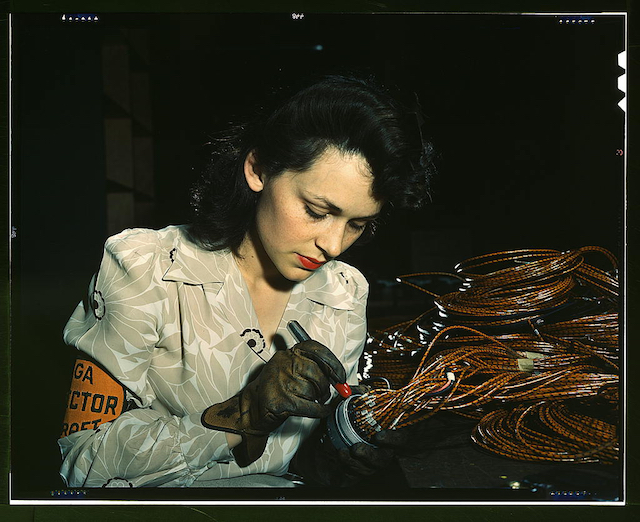We live in the Age of Restraint. Oh, it may not seem that way. Humans still reproduce at bacterial, rather than primate, rates. And as this weird new kind of “bacterium” grows, unlike any bacterial species, each member consumes more: humans are getting richer all the time (and I don’t just mean the 1%.)
People already consume over half of our planet’s total biological productivity. Imagine – more than one half of everything produced anywhere on earth and in the seas, over one half of all the life we know about anywhere in the entire universe, consumed by a single species. That leaves less than one half for the over 10 million other species we share our world with. We are not even the 1%, we are the 0.00001%.
And yet, despite appearances, restraint is what we are dealing with. Once we achieve a typical middle class lifestyle, things bog down. There’s little or no progress. The threadmill has one forward speed left. It’s called “slow.”
Cleaning the dishes, washing the laundry, heating the house? Same as before: pour in something (detergent, energy) and press a button. Those planes I take to visit my clients? A bit slower than the ones I took with my parents 40 years ago (must save fuel, you see. And wait for take-off and landing slots.) Driving from their hometown to mine? That’s definitely slower: more speed limits, more traffic. Being a billionaire? That’s much, much slower. Your private jet doesn’t go any faster than the charter carrying the proletariat to the beach. It’s just got comfier seats, prettier cabin crew, and parks at a smaller terminal. But it must wait its turn for takeoff and landing slots, just like the rest of us. In the old days, at least, there was the Concorde.
Sure, there’s the Internet. There are magical devices to access it, from pretty much anywhere. Computers everywhere. Handling and communicating information is the one thing that’s outstandingly better than it was 40 years ago. But that, too, is a sign of the age of restraint.
In the middle of all the noise of 2011 – occupy this, overthrow that, great waves of despair washing over the West – only two events really seemed to matter: the one where physics collected its dues, and the one where superstition barged through our collective door. Last March, a power plant on the Japanese coast was overwhelmed by a tsunami, and broke down. And last August, the Shuttle lifted off for its 135th and final voyage to nowhere, also known as low earth orbit.
Reaction to the first event was swift, uncompromising and stupid. Across most of the world, nuclear power expansion plans were put on ice. Some countries decided to get rid of their installed plants altogether. Public superstition had to be assuaged, and damn the consequences.
Public reaction to the second event was more muted, but just as silly. This was the end of the space age, America was relinquishing its leadership in the world, etc. Yet, there, decision-makers ignored the public and respected the physics.
Getting stuff into space means harnessing huge quantities of energy to achieve the extraordinary speeds required: anything in earth orbit travels about 15 times faster than a bullet as it leaves the barrel of a rifle. Lifting the Space Shuttle into orbit means managing an energy quantity that is a almost a billion times larger than the energy contained in a rifle cartridge’s powder. Doing so without ripping your craft to shreds is really, really hard.
That’s why the Shuttle failed. It operated too close to the limits of what material science – physics – allowed. Every flight costs a billion dollars. And it was pretty pointless, since sending people into space serves no obvious purpose (unlike sending robots and satellites.)
What both events show is that we have reached the limit of our ability to harness and use concentrated energy. First, we are already bumping into the physics limiting the strengths of materials. Engineering machines that can use huge amounts of energy is really hard, and will always remain hard.
Second, we are afraid. Anything that packs a lot of punch into a small volume is by definition dangerous.
Third, we refuse to use the right power source. There are only two kinds of concentrated energy sources: fossil fuels and nuclear. The first is running low and messing up our atmosphere, and we irrationally dislike the second. Small nuclear reactors could do all sorts of things, including powering planes or cars. But that won’t happen – our phobias won’t allow it. Nothing else seems to be on the horizon either (renewables may feed cities, but are unlikely to power rockets.)
And that is why the Internet is the only proper innovation of the last forty years. Unlike stuff, moving information around demands very little energy. The Internet can be powered by windmills.
Anything that demands the concentrated application of a large amount of energy seems to be permanently out of bounds. That means there won’t ever be anything that allows us to move our bodies and our stuff at really fast speeds. There won’t ever be mass supersonic plane transport. No orbital holidays for the masses. No honeymoons on the Moon, no Google cars wizzing by at 400 kph. We are doomed to be slow forever, to remain stuck in the Age of Restraint.
Photograph courtesy of Mypouss. Published under a Creative Commons license.






The more things change, the more they stay the same.